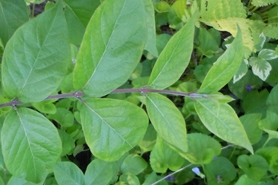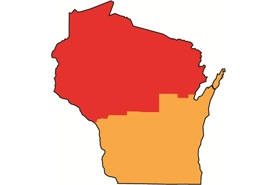Amur honeysuckle
(Lonicera maackii)
A quick-growing deciduous shrub reaching up to 15' tall with a hollow stem pith and pale, shredding bark.
Other names for this plant include:
- Common names: bush honeysuckle, late honeysuckle, Maak's honeysuckle.
Classification in Wisconsin: Prohibited/Restricted (Restricted in Adams, Brown, Buffalo, Calumet, Columbia, Crawford, Dane, Dodge, Fond du Lac, Grant, Green, Green Lake, Iowa, Jefferson, Juneau, Kenosha, Kewaunee, La Crosse, Lafayette, Manitowoc, Marquette, Milwaukee, Monroe, Outagamie, Ozaukee, Racine, Richland, Rock, Sauk, Sheboygan, Vernon, Walworth, Washington, Waukesha, Waupaca, Waushara and Winnebago counties; Prohibited elsewhere)
- Ecological Threat
-
- Thrives in forests, forest edges and open grasslands forming dense stands.
- Plants leaf out early and lose leaves late in the season which shade out native species and out-competes for nutrients.
- Maybe allelopathic -- releases chemical compounds that inhibit the growth of other plants.
- Identification
-
Leaves: Dark green and elliptical to oblong. Leaves come to a long, sharp point and have hair along veins on the underside.
Flowers: Fragrant, white-pink flowers bloom in early spring (May-June), fading to yellow and forming in leaf axils. Flower stems are short and hairy.
Fruits & seeds: Bright red fruits in clusters of 2-4.
Roots: Shallow, fibrous roots.
Similar species: Bell’s honeysuckle (Lonicera x bella; invasive), Morrow’s honeysuckle (L. morrowii; invasive) and Tatarian honeysuckle (L. tatarica; invasive) are all very similar and equally invasive to Amur honeysuckle. Leaves on these Eurasian bush honeysuckles are more oblong, slightly hairy, and have a dull end. Flowers range from white-pink and also form in the leaf axils. Native bush honeysuckles (Diervilla lonicera) are smaller, have elongated fruit capsules, groups of 3-7 yellow flowers that turn reddish, and the stem has a solid pith. Fly-honeysuckles; native (Lonicera canadensis) also has red berries, but a solid stem pith, and white flowers that occur at the end of the branch (terminal) and hang down. Other native honeysuckles are woody vines that have connate (joined) terminal leaves below a cluster of flowers.
- Control
-
Mechanical: Hand-pull or dig out seedlings or small plants; remove the entire root system. It is important to follow up for several years.
Chemical: Cut stump treatments of glyphosate or basal bark with triclopyr.
- Resources
- Sources for content:
- Czarapata, Elizabeth; Invasive Plants of the Upper Midwest: an illustrated guide to their identification and control. The University of Wisconsin Press. 2005. Pg. 32-35


